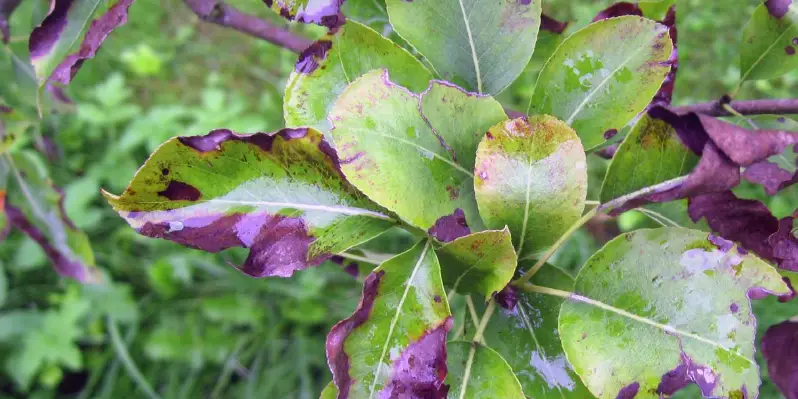Marigolds are beautiful, cheerful flowers that are easy to grow. They come in a variety of colors, including yellow, orange, and red. But what does it mean when marigold leaves turn purple?
This is a question that many gardeners have, and the answer can be a bit complicated. In this blog post, we will discuss the possible reasons why your marigold leaves are turning purple, and what you can do to remedy the problem. We will also provide some tips on how to prevent this from happening in the future!
Why Is My Marigold Turning Purple?
Nutrient deficiency is the most likely reason for marigold leaves turning purple. This can be caused by a lack of nitrogen, phosphorus, or potassium in the soil. If your marigold is not getting enough of these essential nutrients, it will start to show signs of stress, and the leaves will begin to turn purple.
Typically, it’s a lack of phosphorus that is the problem. This nutrient is essential for plant growth, and it is often the first to be depleted in the soil. If your marigold leaves are turning purple, you should fertilize with phosphorus-rich fertilizer to correct the deficiency.
What is Phosphorus?
Phosphorus is an essential mineral nutrient for plants, helping them to grow and stay healthy. It is involved in many important plant processes, including photosynthesis, respiration, cell division, and cell differentiation.
Phosphorus is found in the soil and taken up by plants through their roots. It is a component of many plant tissues, including the chloroplasts, which are responsible for photosynthesis. Phosphorus deficiency can cause problems with plant growth and development.
Luckily, there are many ways to correct a phosphorus deficiency. Fertilizing with a phosphorus-rich fertilizer is the most common and effective method. You can also add phosphate rock or bone meal to your garden soil to help increase the levels of this essential nutrient.
How to Treat Purple Marigold Leaves?
If your marigold leaves are turning purple, the first step is to test the soil. You can do this with a simple at-home soil test kit. This will tell you what nutrients are present in the soil and in what quantities.
Soil acidity can also inhibit phosphorous intake, so it’s important to make sure your soil is not too acidic. The ideal pH range for marigolds is between six and seven. You can test the pH of your soil with an at-home soil test kit as well.
If the soil test reveals a lack of phosphorus, you should fertilize with a phosphorus-rich fertilizer. You can also add phosphate rock or bone meal to the soil to help increase the levels of this essential nutrient.
I recommend using fertilizer for blooming plants to give your marigolds the nutrients they need to produce beautiful flowers. This is a good one (Amazon link) that I’ve had success with over the years.
Simply sprinkle the fertilizer around the base of the plant, being careful not to get any on the leaves. Water deeply to help the nutrients reach the roots. This should be done every two weeks until the leaves return to their normal color.
If you are unsure of what type of fertilizer to use, ask for help at your local garden center. The staff should be able to recommend a product that will correct the nutrient deficiency and help your marigold leaves return to their normal color.
Once you have corrected the nutrient deficiency, you should see a marked improvement in your marigold’s health and growth. However, it is important to keep an eye on the plant and make sure that the deficiency does not recur. Regular soil testing and fertilization will help to ensure that your marigold stays healthy and vibrant.
In addition to fertilizing, you can also try adding organic matter to the soil. This will help to improve drainage and aeration, both of which are important for plant health. Compost, manure, and peat moss are all good options for adding organic matter to your garden soil.

Preventing Purple Marigold Leaves
The best way to prevent purple marigold leaves is to make sure that the plant is getting all of the nutrients it needs. This can be accomplished by regularly fertilizing with a balanced fertilizer and by conducting soil tests to ensure that the soil is not deficient in any essential nutrients.
In addition, it is important to water your marigold regularly and deeply. This will help to ensure that the roots are getting enough moisture and the roots are able to take up all of the nutrients from the soil.
Pests are known to cause problems with marigolds, so it is important to keep an eye out for them. If you see any pests on the plant, be sure to remove them immediately. You can also try using a natural insecticide to help deter pests and keep your marigold healthy and strong.
Cold weather can also trigger purple leaves in marigolds. If the temperature drops suddenly, it can reduce the uptake of phosphorus in the plant. To prevent this, make sure to protect your marigolds from frost by covering them with a cloth or blanket if frost is expected.
Finally, make sure that your marigold is planted in an area that receives plenty of sunlight. Marigolds need at least six hours of sunlight each day to thrive. If they are not getting enough light, they may start to show signs of stress, including purple leaves.
Should I Prune Purple Marigold Leaves?
It is not a requirement to prune your marigold leaves if they turn purple. Generally, I only prune leaves when a disease is present or they are starting to die off. If your marigold leaves are turning purple due to a nutrient deficiency, you can simply fertilize the plant and provide it with the nutrients it needs.
If you do decide to prune your marigold leaves, be sure to use sharp, clean shears. This will help to prevent the spread of disease. Start by cutting off any leaves that are heavily discolored or damaged. Then, cut back the remaining leaves by about one-third.
After you have pruned your marigold leaves, be sure to fertilize the plant and water it deeply. This will help it to recover from the pruning and encourage new, healthy growth.
Conclusion
Purple leaves on your marigold plant can be a cause for concern. However, in most cases, they are nothing to worry about. By testing the soil and fertilizing accordingly, you can usually fix the problem and get your marigold back to its normal, healthy self.
If you are still having trouble with your marigold, or if the leaves are severely damaged, you may need to prune them back. This will encourage the plant to focus its energy on new growth. Just be sure to use sharp, clean shears and fertilize and water deeply after pruning.
I hope this article helped troubleshoot your purple marigold leaves. As always, if you have any further questions, please feel free to reach out to me in the comments below. Happy gardening!
Tim is an avid gardener from the UK. He was the founder of PlantCarer.com from 2021 to Sep 2023. He sold PlantCarer.com to Aaron. He has since started his own business called Seed To Supper, which provides new gardeners all the materials you need in a box (pots, seeds, compost and instructions) to grow your own delicious and nutritious vegetables and herbs from start to finish – no garden required.








0 Comments